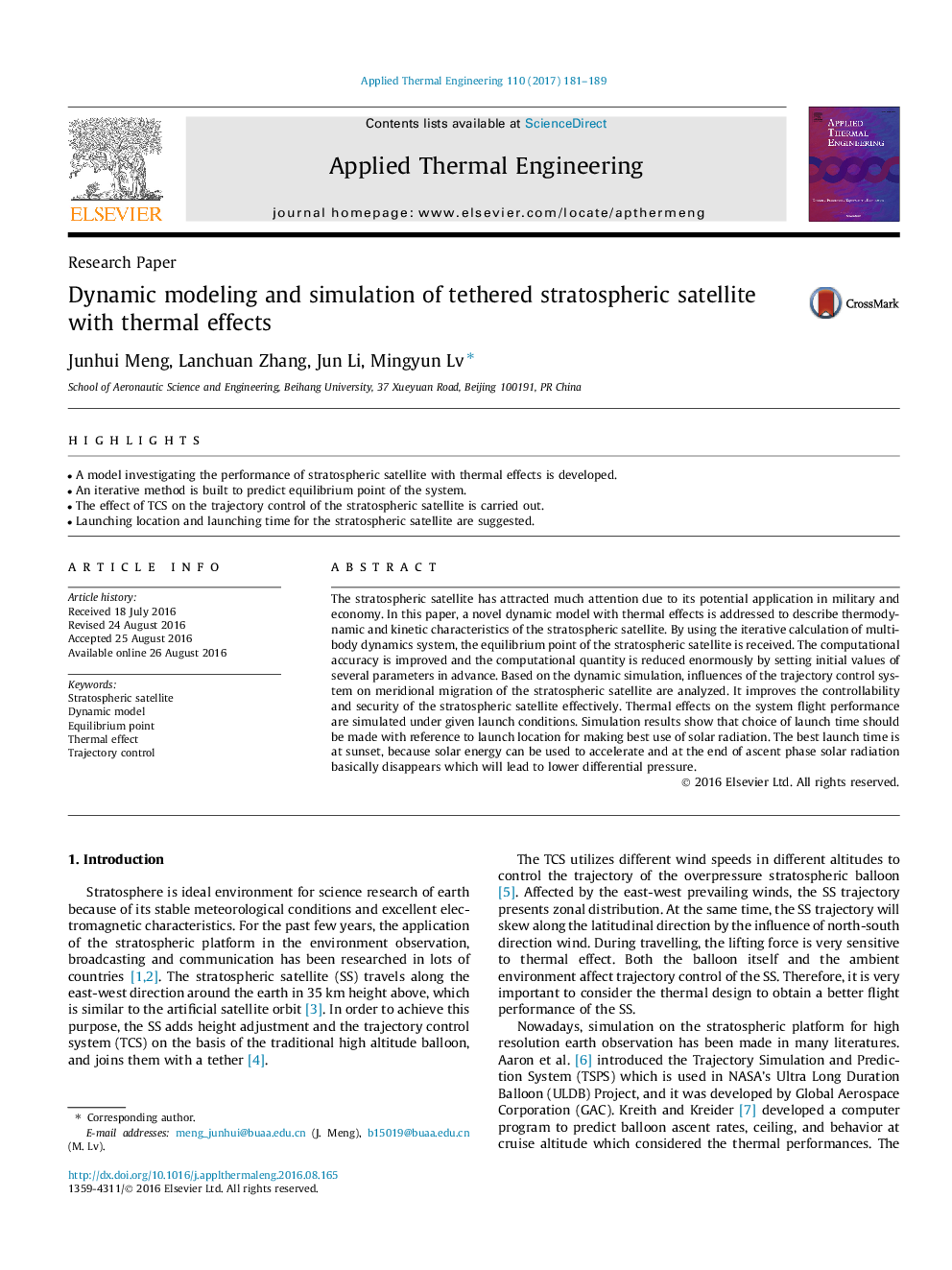| کد مقاله | کد نشریه | سال انتشار | مقاله انگلیسی | نسخه تمام متن |
|---|---|---|---|---|
| 4992006 | 1457119 | 2017 | 9 صفحه PDF | دانلود رایگان |
عنوان انگلیسی مقاله ISI
Dynamic modeling and simulation of tethered stratospheric satellite with thermal effects
ترجمه فارسی عنوان
مدل سازی پویا و شبیه سازی ماهواره استراتوسفر وابسته با اثرات حرارتی
دانلود مقاله + سفارش ترجمه
دانلود مقاله ISI انگلیسی
رایگان برای ایرانیان
کلمات کلیدی
ماهواره استراتوسفری، مدل پویا نقطه تعادل، اثر حرارتی، کنترل مسیر
ترجمه چکیده
ماهواره استراتوسفری به دلیل کاربرد بالقوه آن در ارتش و اقتصاد توجه زیادی به خود جلب کرده است. در این مقاله، یک مدل دینامیکی جدید با اثرات حرارتی برای توصیف ویژگی های ترمودینامیکی و جنبشی ماهواره استراتوسفر استفاده می شود. با استفاده از محاسبات تکراری سیستم دینامیک چندگانهای، نقطه تعادل ماهواره استراتوسفر دریافت می شود. دقت محاسباتی بهبود یافته است و مقدار محاسباتی به میزان قابل توجهی کاهش می یابد با تنظیم مقادیر اولیه چندین پارامتر به طور پیش فرض. براساس شبیه سازی دینامیکی، تأثیرات سیستم کنترل مسیر در مهاجرت مریخ ماهواره استراتوسفر، تحلیل می شود. این قابلیت کنترل و امنیت ماهواره استراتوسفر را به طور موثر بهبود می بخشد. اثرات حرارتی بر روی عملکرد پرواز سیستم تحت شرایط راه اندازی داده شده شبیه سازی شده است. نتایج شبیه سازی نشان می دهد که انتخاب زمان راه اندازی باید با مراجعه به محل راه اندازی برای استفاده بهتر از تابش خورشیدی ساخته شود. بهترین زمان راه اندازی در غروب خورشید است، زیرا انرژی خورشیدی را می توان برای سرعت بخشیدن و در پایان فاز صعود، تابش خورشیدی اساسا ناپدید می شود که منجر به فشار دیفرانسیل پایین می شود.
موضوعات مرتبط
مهندسی و علوم پایه
مهندسی شیمی
جریان سیال و فرایندهای انتقال
چکیده انگلیسی
The stratospheric satellite has attracted much attention due to its potential application in military and economy. In this paper, a novel dynamic model with thermal effects is addressed to describe thermodynamic and kinetic characteristics of the stratospheric satellite. By using the iterative calculation of multi-body dynamics system, the equilibrium point of the stratospheric satellite is received. The computational accuracy is improved and the computational quantity is reduced enormously by setting initial values of several parameters in advance. Based on the dynamic simulation, influences of the trajectory control system on meridional migration of the stratospheric satellite are analyzed. It improves the controllability and security of the stratospheric satellite effectively. Thermal effects on the system flight performance are simulated under given launch conditions. Simulation results show that choice of launch time should be made with reference to launch location for making best use of solar radiation. The best launch time is at sunset, because solar energy can be used to accelerate and at the end of ascent phase solar radiation basically disappears which will lead to lower differential pressure.
ناشر
Database: Elsevier - ScienceDirect (ساینس دایرکت)
Journal: Applied Thermal Engineering - Volume 110, 5 January 2017, Pages 181-189
Journal: Applied Thermal Engineering - Volume 110, 5 January 2017, Pages 181-189
نویسندگان
Junhui Meng, Lanchuan Zhang, Jun Li, Mingyun Lv,
